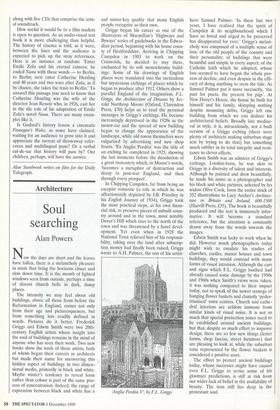Architecture
Soul searching
Alan Powers
Now the days are short and the leaves have fallen, there is a melancholy pleasure in mists that bring the horizons closer and slow down time. It is the month of lighted windows seen from outside, perhaps a time of distant church bells in dark, damp places.
The intensity we may feel about old buildings, above all those from before the Reformation in England, comes not only from their age and picturesqueness, but from something less readily defined in words. Pictures do it better. Frederick Griggs and Edwin Smith were two 20th- century English artists whose insight into the soul of buildings remains in the mind of anyone who has seen their work. Two new books show the work of these artists, both of whom began their careers as architects but made their name for uncovering this hidden aspect of buildings in two dimen- sional media, primarily in black and white. Maybe winter's tendency to reveal form rather than colour is part of the same pro- cess of concentration. Indeed, the range of expression between black and white has a sad minor-key quality that many English people recognise as their own.
Griggs began his career as one of the illustrators of Macmillan's 'Highways and Byways' series of guidebooks in the Edwar- dian period, beginning with his home coun- ty of Hertfordshire. Arriving in Chipping Campden in 1903 to work on the Cotswolds, he decided to stay there, enchanted by its soft monochrome build- ings. Some of his drawings of English places were translated into the meticulous but mysterious etchings of places which he began to produce after 1912. Others show a parallel England of the imagination. F.L. Griggs, the Architecture of Dreams by Jer- rold Northrop Moore (Oxford, Clarendon Press, £70) helps us to read the personal messages in Griggs's etchings. He became increasingly depressed in the 1920s as the motor-car and the spread of new building began to change the appearance of the landscape, while old towns themselves were vulgarised by advertising and new shop fronts. 'Ex Anglia Perdita' was the title of an etching he completed in 1925, showing the last moments before the dissolution of a great monastery which, in Moore's words, 'becomes a metaphor of destruction and decay in post-war England, and then through every prospect'.
In Chipping Campden, far from being an escapist romantic (a role in which he was affectionately depicted by J.B. Priestley in his English Journey of 1934), Griggs took the most practical steps, at his own finan- cial risk, to preserve pieces of unbuilt coun- try around and in the town, most notably Dover's Hill which rises to the north of the town and was threatened by a hotel devel- opment. Yet even when in 1928 the National Trust relieved him of his responsi- bility, taking over the land after subscrip- ion money had finally been raised, Griggs wrote to A.H. Palmer, the son of his artist- Anglia Perdita V, by F.L. hero Samuel Palmer: 'In these last two years, I have realised that the spirit of Campden & its neighbourhood which I have so loved and urged to be preserved has disappeared for ever.' Griggs's melan- choly was composed of a multiple sense of loss: of the old people of the country and their personality; of buildings that were beautiful and simple in every aspect; of the Catholic faith which he adopted, whose loss seemed to have begun the whole pro- cess of decline, and even despair in the effi- cacy of doing anything to stem the tide. As Samuel Palmer put it more succinctly, 'the past for poets, the present for pigs'. At New Dover's House, the house he built for himself and his family, skimping nothing despite mounting debts, Griggs left one building from which we can deduce his architectural beliefs. Broadly late mediae- val in style, it is, miraculously, not a built version of a Griggs etching (there were plenty of architects making suburban stage sets by trying to do that) but something much subtler in its total integrity and resis- tance to clever effects.
Edwin Smith was an admirer of Griggs's etchings. London-born, he was akin to Griggs in a diversity of talent and interests. Although he painted and drew beautifully, he made his name as a photographer and his black and white pictures, selected by his widow Olive Cook, form the entire stock of 352 illustrations to Lucy Archer's Architec- ture in Britain and Ireland, 600-1500 (Harvill Press, £35). The book is beautifully produced and the text is immensely infor- mative. It will become a standard reference, but the attention is constantly drawn away from the words towards the images.
Edwin Smith was lucky to work when he did. However much photographers today might wish to emulate his studies of churches, castles, manor houses and town buildings, they would contend with many forms of visual intrusion. Although the cars and signs which F.L. Griggs loathed had already caused some damage by the 1950s and 1960s when Smith's views were taken, it was nothing compared to their impact today, not to speak of the newer scourge of hanging flower baskets and clumsily 'pedes- trianised' town centres. Church and cathe- dral interiors are seldom immune from similar kinds of visual noise. It is not so much that special protection zones need to be established around ancient buildings, but that, despite so much effort to improve design, there are so few new things (letter forms, shop fascias, street furniture) that are pleasing to look at, while the suburban taste represented by the flower baskets is considered a positive asset.
The effort to protect ancient buildings today, whose successes might have caused even F.L. Griggs to revise some of his gloomier predictions, is still at risk from our wider lack of belief in the availability of beauty. The iron still lies deep in the protestant soul.


















































































 Previous page
Previous page